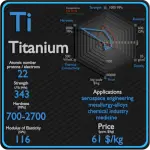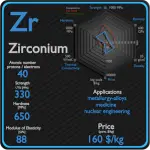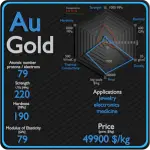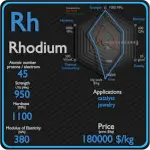This article contains comparison of key thermal and atomic properties of tungsten and platinum, two comparable chemical elements from the periodic table. It also contains basic descriptions and applications of both elements. Tungsten vs Platinum.

Tugsten and Platinum – About Elements


Source: www.luciteria.com
Tungsten and Platinum – Applications
Tungsten
Tungsten is widely used metal. Approximately half of the tungsten is consumed for the production of hard materials – namely tungsten carbide – with the remaining major use being in alloys and steels. Mining and mineral processing demand wear-resistant machines and components, because the energies and masses of interacting bodies are significant. For this purposes, materials with the highest wear-resistance must be used. For example, tungsten carbide is used extensively in mining in top hammer rock drill bits, downhole hammers, roller-cutters, long wall plough chisels, long wall shearer picks, raiseboring reamers, and tunnel boring machines. The remaining 40% is generally used to make various alloys and specialty steels, electrodes, filaments, wires, as well as diverse components for electric, electronic, heating, lighting, and welding applications. High-speed steels are complex iron-base alloys of carbon, chromium, vanadium, molybdenum, or tungsten (as much as 18%), or combinations there of.
Platinum
Platinum is primarily an industrial metal. It is a critical material for many industries and is considered a strategic metal. Platinum is used as a catalyst, platinum is mostly found in vehicle catalytic converters that reduce toxic exhaust chemicals, and also in fuel cells to increase efficiency. The most common use of platinum is as a catalyst in chemical reactions, often as platinum black. In catalytic converters, platinum allows the complete combustion of low concentrations of unburned hydrocarbons from the exhaust into carbon dioxide and water vapor. Platinum has been used in thermocouple devices that measure temperature with high accuracy. Platinum is a component in magnetic coatings for high-density hard disk drives and some of the newer optical storage systems.
Tungsten and Platinum – Comparison in Table
| Element | Tungsten | Platinum |
| Density | 19.25 g/cm3 | 21.09 g/cm3 |
| Ultimate Tensile Strength | 980 MPa | 150 MPa |
| Yield Strength | 750 MPa | 70 MPa |
| Young’s Modulus of Elasticity | 411 GPa | 168 GPa |
| Mohs Scale | 7.5 | 3.5 |
| Brinell Hardness | 3000 MPa | 400 MPa |
| Vickers Hardness | 3500 MPa | 550 MPa |
| Melting Point | 3410 °C | 1772 °C |
| Boiling Point | 59300 °C | 3827 °C |
| Thermal Conductivity | 170 W/mK | 72 W/mK |
| Thermal Expansion Coefficient | 4.5 µm/mK | 8.8 µm/mK |
| Specific Heat | 0.13 J/g K | 0.13 J/g K |
| Heat of Fusion | 35.4 kJ/mol | 19.6 kJ/mol |
| Heat of Vaporization | 824 kJ/mol | 510 kJ/mol |













